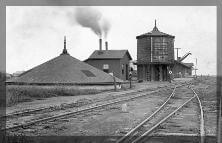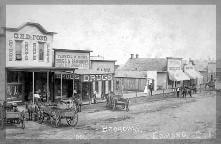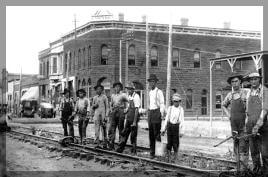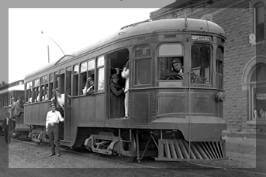Edmond History
 At noon on April 22, 1889, everything changed at Edmond Station on the Santa Fe Railroad line. In the morning there was station agent, John W. Steen, his wife and 2-year-old son and a couple of railroad workers. By nightfall there were 100 to 150 people, mostly men, busy trying to organize a town and find a place to bed down.
At noon on April 22, 1889, everything changed at Edmond Station on the Santa Fe Railroad line. In the morning there was station agent, John W. Steen, his wife and 2-year-old son and a couple of railroad workers. By nightfall there were 100 to 150 people, mostly men, busy trying to organize a town and find a place to bed down.
 What a day it had been. Beginning at noon (and in some cases “sooner”) settlers poured over the starting points for the Oklahoma Land Run of 1889, all eager, many desperate, to secure a piece of the free land in the Unassigned Lands of central Oklahoma. They arrived by railroad, wagon, buggy, horseback and on foot. It has even been said one man rode his bicycle. While many people were bound for the larger proposed settlements of Oklahoma Station (now Oklahoma City), Guthrie and Norman, many found their way to Edmond Station.
What a day it had been. Beginning at noon (and in some cases “sooner”) settlers poured over the starting points for the Oklahoma Land Run of 1889, all eager, many desperate, to secure a piece of the free land in the Unassigned Lands of central Oklahoma. They arrived by railroad, wagon, buggy, horseback and on foot. It has even been said one man rode his bicycle. While many people were bound for the larger proposed settlements of Oklahoma Station (now Oklahoma City), Guthrie and Norman, many found their way to Edmond Station.
This coaling and watering stop had been established in March, 1887 by the Santa Fe Railroad which built a line north and south across Indian Territory. Located at milepost 103, it was first called Summit for the high elevation near this point but within 12 days the station was designated Edmond for Santa Fe official Edmond Burdick.

Station agent Steen, wife Cordelia and young son Charlie lived in a little house by the tracks. Mrs. Steen started a small business, cooking meals for the railroad crews stopping for coal and water and the ranchers and cowboys bringing cattle to ship north on the railroad to market. Edmond Station received freight bound for the trading posts in the Iowa and Kickapoo reservations to the east so the area was not unknown to many of the new settlers.
 But now the Run was over and the work of building new towns, homes and businesses and new family farms on what had been barren prairie and timber land the day before would begin. Within days the wives and children of the men already in Edmond began to arrive with their household goods. It wasn’t long before a need for a school to educate the children was voiced and an industrious group of women formed a Ladies School Aid Society and set out to collect supplies and money to build a school house. Due to their diligence, and refusal to take “no” for an answer, the new school was completed in August of 1889. The first class of 19 pupils met on September 16. No tuition was charged as enough money had been contributed to pay the teacher’s salary…$240.00 for an eight-month term.
But now the Run was over and the work of building new towns, homes and businesses and new family farms on what had been barren prairie and timber land the day before would begin. Within days the wives and children of the men already in Edmond began to arrive with their household goods. It wasn’t long before a need for a school to educate the children was voiced and an industrious group of women formed a Ladies School Aid Society and set out to collect supplies and money to build a school house. Due to their diligence, and refusal to take “no” for an answer, the new school was completed in August of 1889. The first class of 19 pupils met on September 16. No tuition was charged as enough money had been contributed to pay the teacher’s salary…$240.00 for an eight-month term.
 Edmond had hopes of being the seat of a proposed county to be named Ventura but no such county was formed. The town then decided to try for one of the institutes of higher learning and was able to get the Territorial Normal School for the training of teachers. Classes began in November of 1891 in the Methodist church. January 13, 1893, the Normal building, known today as Old North Tower, was close enough to being finished for classes to begin.
Edmond had hopes of being the seat of a proposed county to be named Ventura but no such county was formed. The town then decided to try for one of the institutes of higher learning and was able to get the Territorial Normal School for the training of teachers. Classes began in November of 1891 in the Methodist church. January 13, 1893, the Normal building, known today as Old North Tower, was close enough to being finished for classes to begin.
The town was growing and prospering. In July of 1890 there was a population of 500 and by October of 1891 the population was 1,000. The streets were graded, there were three public water wells and trees had been planted in the park on North Broad Street (now Broadway).
Coal oil street lights appeared in 1892 and in 1901 a telephone system was installed with one long distance line and 45 local phones. Wooden sidewalks had been serving the town for several years but in 1902 the city council ordered all sidewalks to be built of brick, flagstone or asphalt.
The Edmond Fire Company was organized in 1903 but structures still burned to the ground. The City Council finally issued an ordinance in 1905 saying every occupant of the lots on Broadway were to keep a barrel of water and one peck of salt on hand in case of fire emergencies.

November 16, 1907, Edmond celebrated statehood for Oklahoma. Territorial days were over and the citizens of Edmond prepared to move ahead developing their village into a modern town.
